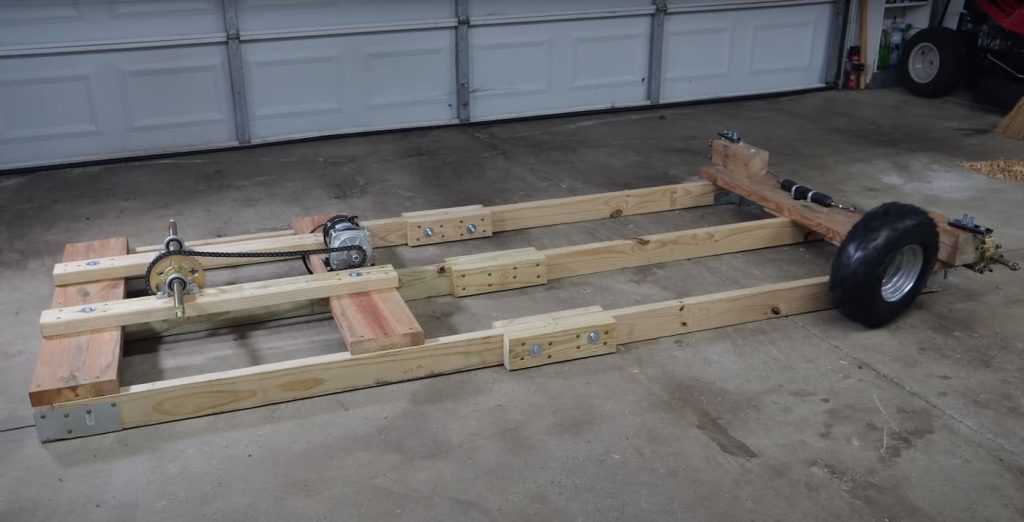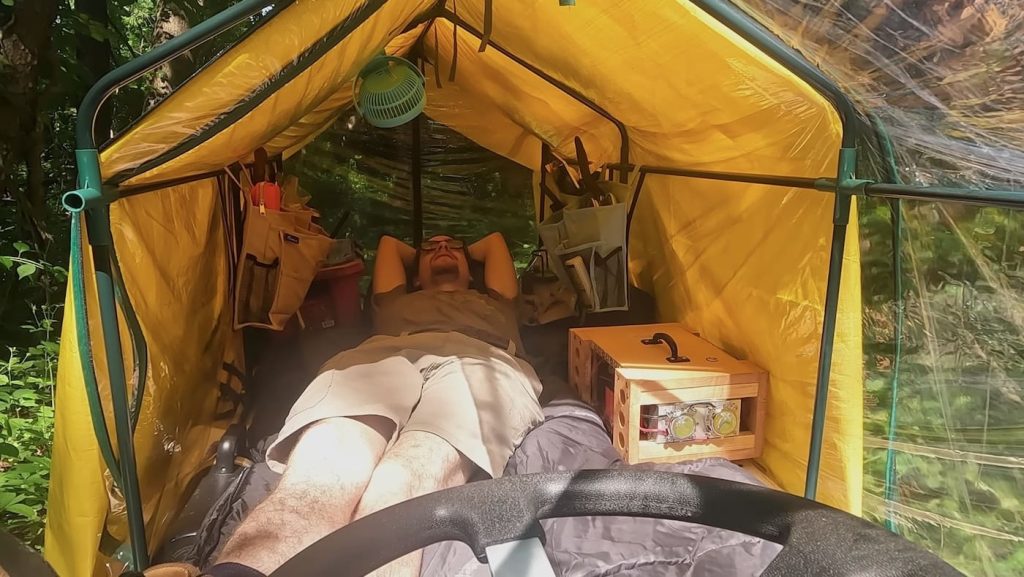This guy built a tiny, off-road electric camper with tank tracks
Ever wonder what a DIY electric camper with tank tracks would look like? You probably didn’t expect something quite like this.
The YouTube channel Quiet Nerd set out to build just that, and the result is surprisingly easy to follow.
He used mainly low-tech construction methods to build something that most people could probably handle in their garage, at least with a bit of ingenuity and a decent collection of tools.
The frame started with a pressure treated 2×4 base, not unlike a backyard deck. Lawn tractor wheels were mounted on steering knuckles built right onto the 2×4 frame.
A 500W DC motor is mounted onto the rear of the frame and connected via a chain drive to the rear axle. A set of tank treads were used in the rear instead of typical wheels to give the camper better off-road crawling performance.



For steering, the builder used a steering kit from a go-kart that employs a shrunken-down version of the rack and pinion steering system that’s probably in your car. He had to weld on some custom tie rods, which is probably the only step that would trip up most people – unless they have their own welder in their garage.
The steering wheel is charmingly built into another 2×4 frame and bolted directly to the wooden floor of the frame.
The 24V motor runs off a 12V battery. To make that seeming impossibility work, a boost converter is used to double the voltage of the battery. The PWM controller for the motor is mounted in a plastic junction box along with a relay and the throttle wiring. Off-road LED lighting was also added to the front and rear.
For the living quarters, the builder used an actual greenhouse. It came with zippered panels that made a convenient door for entering and exiting, kept the vehicle waterproof, and created a clear windshield. Three birds, one stone.
To prevent the camper from becoming too hot because of a literal greenhouse effect, he used a large tarp to cover most of the clear plastic. The camper was then stocked with all of the necessities for a reasonably comfortable camping trip, including a camp kitchen and some entertainment.

To test the off-road camper, the builder took it out into the woods for an overnight camping trip.
While it seems to travel surprisingly well over flat ground, even when traversing forest floor without blazed trails, the builder did admit that it felt a bit underpowered. He added that he might have been better served to use a 36V motor and three batteries to create more power. With a single 12V battery boosted to power a 24V motor, the entire rig is estimated to run for around 2.5 hours on a charge. And based on the slow crawling speed, that probably works out to a fairly short range. For more range though, it’d be easy to simply add more batteries in parallel. A solar panel might be useful for trickle charging, though the forested area he tested it in wouldn’t allow very efficient solar charging.
Overall, it took around four days to build the camper and was largely considered a success by the builder, though with the potential for a future upgrade to increase power looming.
It’s not the first micro-camper we’ve seen here, or even the second. But it is the first off-road micro-camper, and helps to showcase how simple electric vehicle technology truly is. A single small motor, a simple PWM controller box and a 12V battery are all it took to power this off-road explorer. It’s not the prettiest thing out there, but it sure does look like a fun way to go camping.
Check out the full video below to follow along with the build and join in the camping adventure.
Image screenshot via YouTube

Ever wonder what a DIY electric camper with tank tracks would look like? You probably didn’t expect something quite like this.
The YouTube channel Quiet Nerd set out to build just that, and the result is surprisingly easy to follow.
He used mainly low-tech construction methods to build something that most people could probably handle in their garage, at least with a bit of ingenuity and a decent collection of tools.
The frame started with a pressure treated 2×4 base, not unlike a backyard deck. Lawn tractor wheels were mounted on steering knuckles built right onto the 2×4 frame.
A 500W DC motor is mounted onto the rear of the frame and connected via a chain drive to the rear axle. A set of tank treads were used in the rear instead of typical wheels to give the camper better off-road crawling performance.



For steering, the builder used a steering kit from a go-kart that employs a shrunken-down version of the rack and pinion steering system that’s probably in your car. He had to weld on some custom tie rods, which is probably the only step that would trip up most people – unless they have their own welder in their garage.
The steering wheel is charmingly built into another 2×4 frame and bolted directly to the wooden floor of the frame.
The 24V motor runs off a 12V battery. To make that seeming impossibility work, a boost converter is used to double the voltage of the battery. The PWM controller for the motor is mounted in a plastic junction box along with a relay and the throttle wiring. Off-road LED lighting was also added to the front and rear.
For the living quarters, the builder used an actual greenhouse. It came with zippered panels that made a convenient door for entering and exiting, kept the vehicle waterproof, and created a clear windshield. Three birds, one stone.
To prevent the camper from becoming too hot because of a literal greenhouse effect, he used a large tarp to cover most of the clear plastic. The camper was then stocked with all of the necessities for a reasonably comfortable camping trip, including a camp kitchen and some entertainment.

To test the off-road camper, the builder took it out into the woods for an overnight camping trip.
While it seems to travel surprisingly well over flat ground, even when traversing forest floor without blazed trails, the builder did admit that it felt a bit underpowered. He added that he might have been better served to use a 36V motor and three batteries to create more power. With a single 12V battery boosted to power a 24V motor, the entire rig is estimated to run for around 2.5 hours on a charge. And based on the slow crawling speed, that probably works out to a fairly short range. For more range though, it’d be easy to simply add more batteries in parallel. A solar panel might be useful for trickle charging, though the forested area he tested it in wouldn’t allow very efficient solar charging.
Overall, it took around four days to build the camper and was largely considered a success by the builder, though with the potential for a future upgrade to increase power looming.
It’s not the first micro-camper we’ve seen here, or even the second. But it is the first off-road micro-camper, and helps to showcase how simple electric vehicle technology truly is. A single small motor, a simple PWM controller box and a 12V battery are all it took to power this off-road explorer. It’s not the prettiest thing out there, but it sure does look like a fun way to go camping.
Check out the full video below to follow along with the build and join in the camping adventure.
Image screenshot via YouTube

